So, my interactive fiction project The Solless Galaxy ended up stalling a bit earlier and longer than expect. I knew I was going to eventually have periods with a bit longer time between installments than several days, but life intervened and before I knew it I'm two months past the last update.
But, to try and get back into things, I'm just going to start with a post discussing something I did before having to drop work on updates completely: designing the spaceship to which our band of protagonists hope to return (if they survive the station-tomb that is).
This will obviously be a bit spoilerish, so if you really don't care unless this is revealed properly in the story, turn back now. Otherwise, let me share with you the basic design:
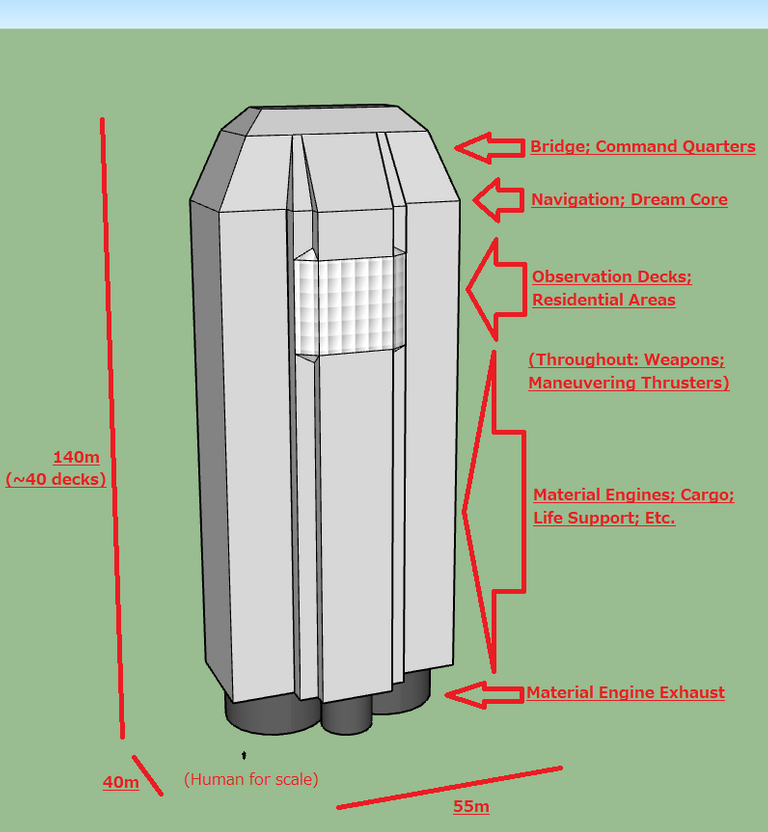
This is all made in SketchUp. My go-to free 3D modelling program. I'm not much of a visual artist, but between its intuitive controls and warehouse of community models, SketchUp has helped me make rough versions of my ideas for my stories many times. I find 3D modelling both relaxing, and very beneficial. When I have to imagine a space, say a palace or a spaceship, being able to create a quick 3D model of a space that size and put a human-scaled figure into it helps me massively in getting a feel of just how big or small say a 10 by 10 meter chamber really is.
Also, for the Americans among us: 140 meters is ~460 feet; 40 meters is ~130 feet; 55 meters is ~180 feet.
One of my favorite Sci-Fi shows of the past years is The Expanse, and this design is inspired by some of its principles. Primarily, the absence of 'magical' artificial gravity. There is a form of 'magical' FTL in this universe, the mysterious "Dream Core" labeled above, the details of which I won't be revealing except in the actual story. But aside from this FTL drive, there is also a 'normal' thrust-based drive labeled as "Material Engines". This drive provides a continual thrust of roughly 1g which both simulates gravity and provides non-FTL travel.
I have done my best to check the math on this, and yes, this means that non-FTL travel for these ships is quite slow compared to what is common in Sci-Fi settings. Though, still very fast and considerably more than what we could do with current real world technology.
The above image is a bit old, below is a slightly newer version of the ship seen as a single part:
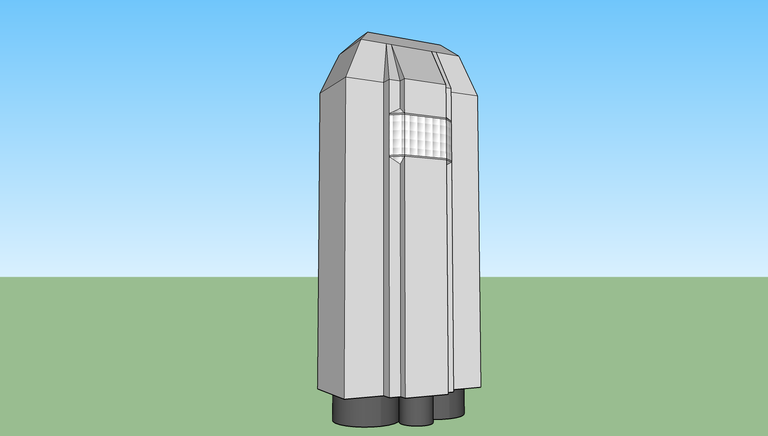
Now, lets split this thing up into decks:

The main effect of The Expanse-inspired design (though I should note, The Expanse certainly did not originate this method of spaceship design) is that spaceships aren't built like naval ships, as they are in many popular Sci-Fi franchises. Instead, ships are built like towers, like an apartment block with a rocket engine in the basement. What does this look like? Well, let's open up this puppy and see!
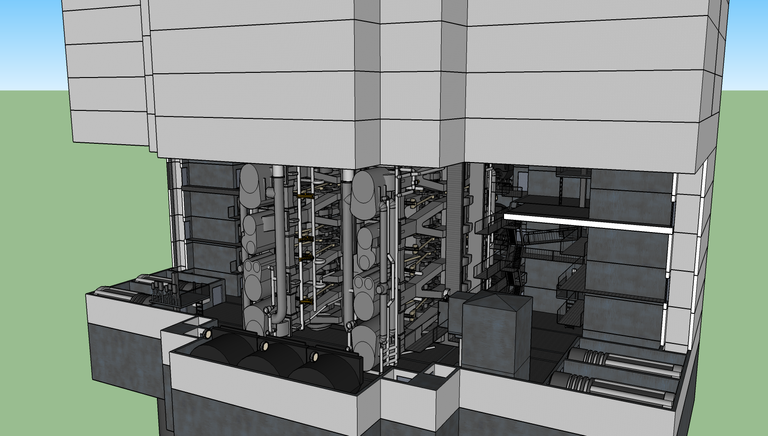
This and the next bunch of images are going to look really odd to those of you sufficiently familiar with old style steam engines to recognize the component parts. As I wrote before, I'm far from a visual artist, so for all these detailed components what I did was take apart a SketchUp Warehouse model of the Titanic and re-used the component parts. Obviously, my intent is not to say that steam engines can produce a continual 1g thrust for an apartment block sized spaceship. Simply, my vision for this engine was as something complex with lots of different parts, but also fairly accessible, but that requires a lot of constant maintenance. So, a giant steam engine looked the part. I imagine all the components having some strange high-tech function, rather than steam-age functions, of course.
If you don't have this problem, what you're seeing is a complex machinery in the middle of six floors of spaceship. The shafts on the right and left are emergency staircases in case of elevator failure. These elevators are perhaps harder to spot, but they're the four small square rooms close to the front.
These elevators would not work as normal elevators, but rather be like shuttles on a rail. They come in sets of two (four such sets in total), and of each set one always goes down and the other always goes up. When a shuttle hits the top or bottom, it switches to the opposite track and heads down. In other words, a dozen or so elevators are constantly running in a loop, a system for which I'm sure there's a technical term I'm forgetting. It's a trickier system than a normal elevator, but a much more space efficient way of moving crew between decks when there are forty decks but only eight elevators.
So, moving on, let's open up a few more decks:
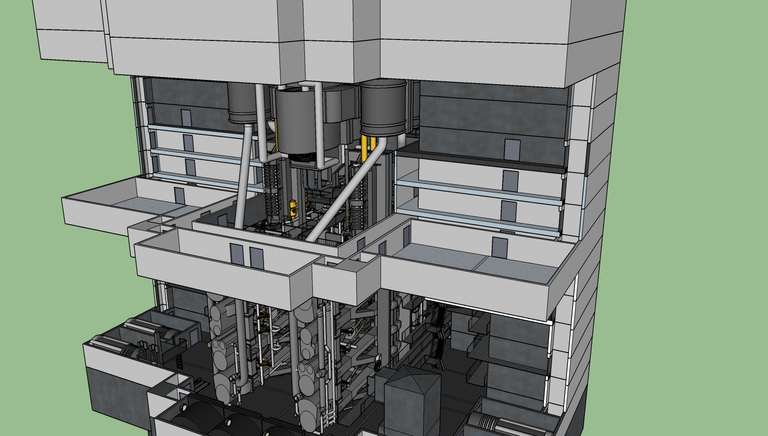
As you can see the engine is quite massive, but after six decks more space starts to open up around it. I imagine these decks to primarily be cargo and shuttle bays, and stuff like that. But possibly some engineers or mechanics would have made a home for themselves on these decks, to never be far from their work.
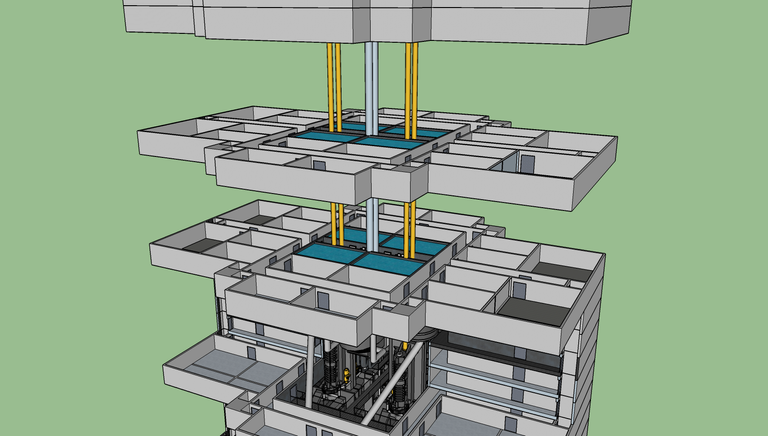
A dozen decks higher, the main engine transitions into fuel tanks, themselves a dozen decks tall. Surrounding them are areas used for various purposes, including occasionally residential. Only the center part of these decks is dedicated to the fuel tanks, with room in the middle for the main fuel pipes as well as various control panels and meters.
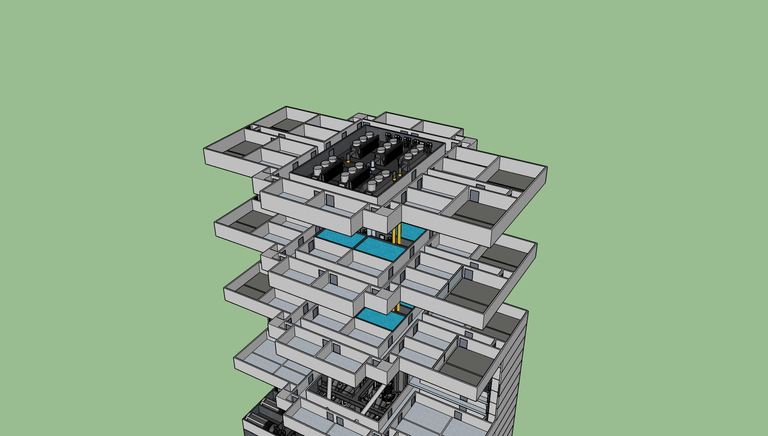
The final end of the material engines is a good two-thirds through the ship's decks. Here there's a secondary engine control room, closer to the bridge. Again, the machinery is meant to depict just generally advanced technology with lots of fidgety bits.
But, while it's nice to have a model for these kinds of cross-sections, the most fun part is putting yourself physically inside the model. So here are a few people-level views:
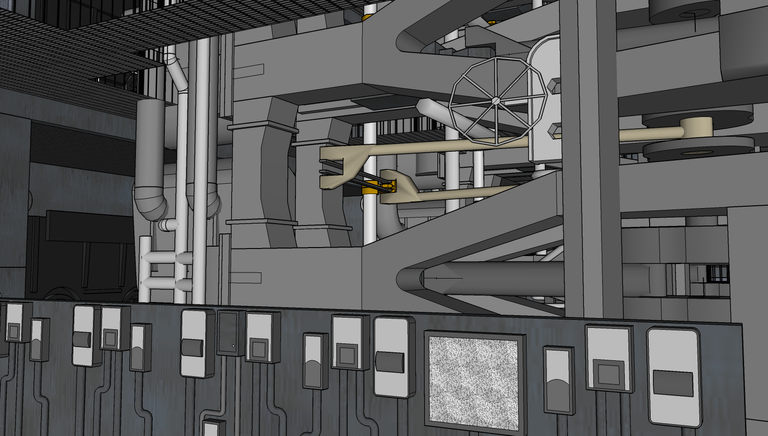
This is a view all the way from the bottom, the primary engine control room.
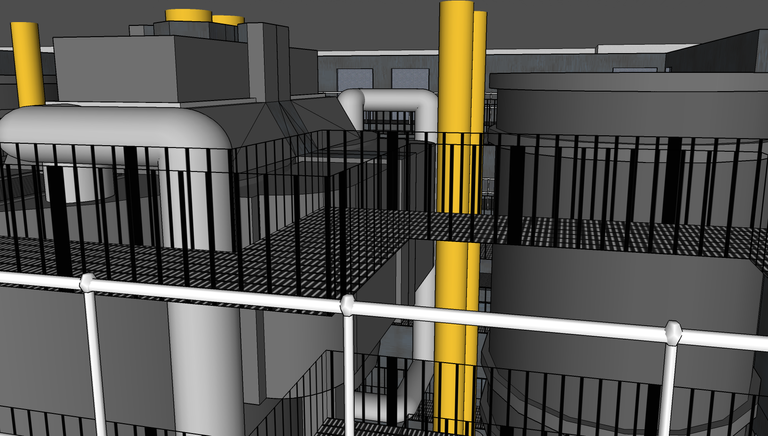
And this is a view all the way up top, before the engines definitively transition into the fuel tanks.
Now, if we lean forward just a bit and look down:
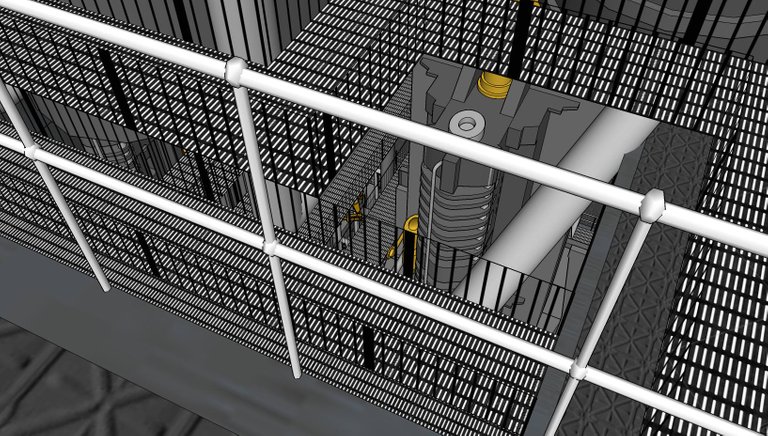
We can see a good half a dozen decks down! I really hope I manage to get to a point where I can write a chase scene across this engine room. Just looking at a picture like the one above makes me want to jump into it!
Okay, so that is the engine. I must admit, it's the most exciting and complete part so far. But I do have some rough outlines of what is present in the final dozen decks:

Above the secondary engine control room, the true residential areas start. Likely, this is not how the ship was originally designed to be inhabited, but in this setting most FTL-capable spaceships are scavenged and repurposed legacy technology. As such, I imagine this habitation to be very make-shift, and homes having been set up on those decks whose original function or purpose has been lost and forgotten. The open rooms on both ends, near the staircase shafts, are meant to indicate shops (with the shopowner making their home in the back).
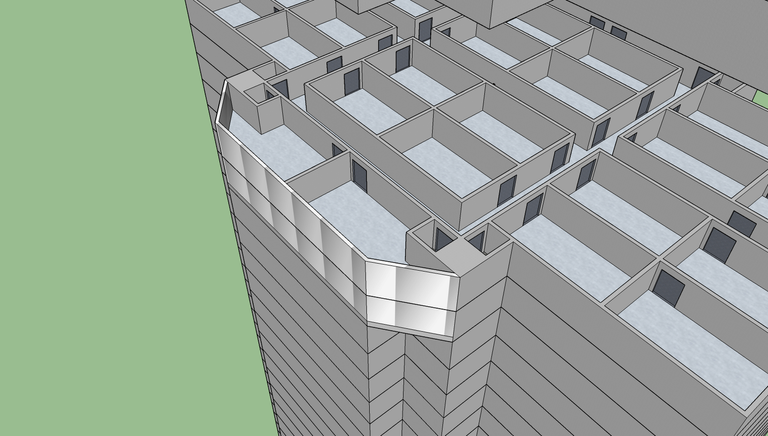
The observation decks aren't anything fancy. Just decks where two rooms have thick (space-)glass so that if there's something to see, the crew can come here to see it. Or to just peer into the darkness of space. Obviously, the glass will protect against most forms of radiation and other such hazards, and in case that is not enough one can simply not be in these rooms at such times. I imagine these decks hold more homes, but also leisure areas such as a tavern and gardens.
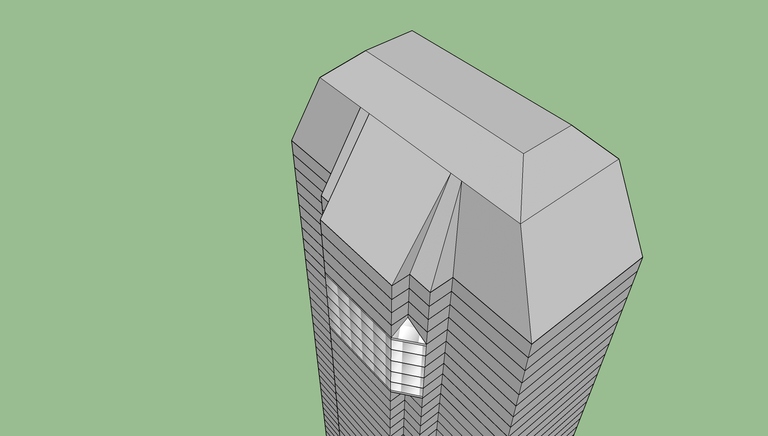
Finally, the top. I haven't made any deck plans here. It should have plenty of armor, the bridge, fancier quarters for the captain and high ranking officers, and so on.
So, that's everything. I hope that was interesting! I'm hoping to get into the business of actual story soon, at minimum I want to finish the current mission so as to not leave this story hanging of a cliff forever.
Many thanks for reading, and see you all around!
The inside detail is amazing. But where is all the weaponry?
The exact location of weaponry isn't currently represented, I was mostly concerned with getting a sense of the general space of the ship. I would imagine weapon systems to be there around every two to three decks or so. This ship is armed, but not armed to the teeth. The potential locations of weapon systems looks something like the image below. Per deck there are probably at most four weapons systems, but their locations vary.
Missile systems are largely internal, other systems (such as energy weapons) are largely external. Direct connections between the outside hull and the inside would be minimized, so that there aren't obvious holes in the armor. Particularly in the case of turrets this means they are more vulnerable to being destroyed by enemy fire, but if they are there is minimal chance of the hull and/or vital systems being compromised.
I think a luck dragon is your best bet. Do what you will.
Congratulations! This post has been upvoted from the communal account, @minnowsupport, by NFB from the Minnow Support Project. It's a witness project run by aggroed, ausbitbank, teamsteem, theprophet0, someguy123, neoxian, followbtcnews, and netuoso. The goal is to help Steemit grow by supporting Minnows. Please find us at the Peace, Abundance, and Liberty Network (PALnet) Discord Channel. It's a completely public and open space to all members of the Steemit community who voluntarily choose to be there.
If you would like to delegate to the Minnow Support Project you can do so by clicking on the following links: 50SP, 100SP, 250SP, 500SP, 1000SP, 5000SP.
Be sure to leave at least 50SP undelegated on your account.